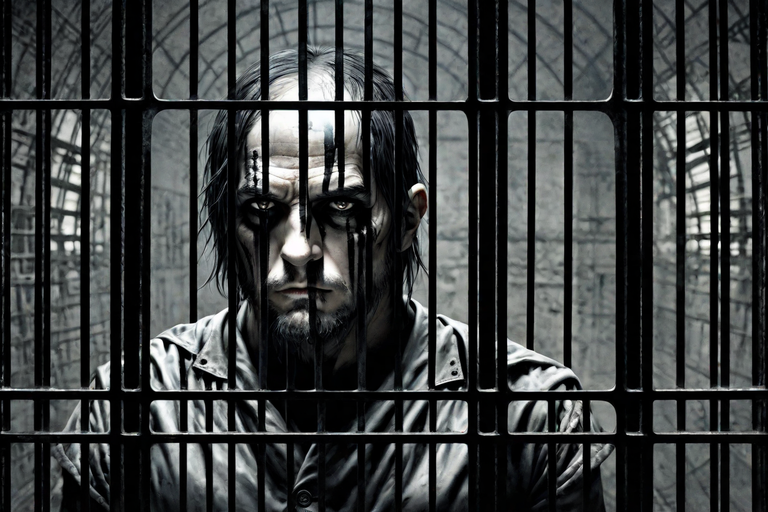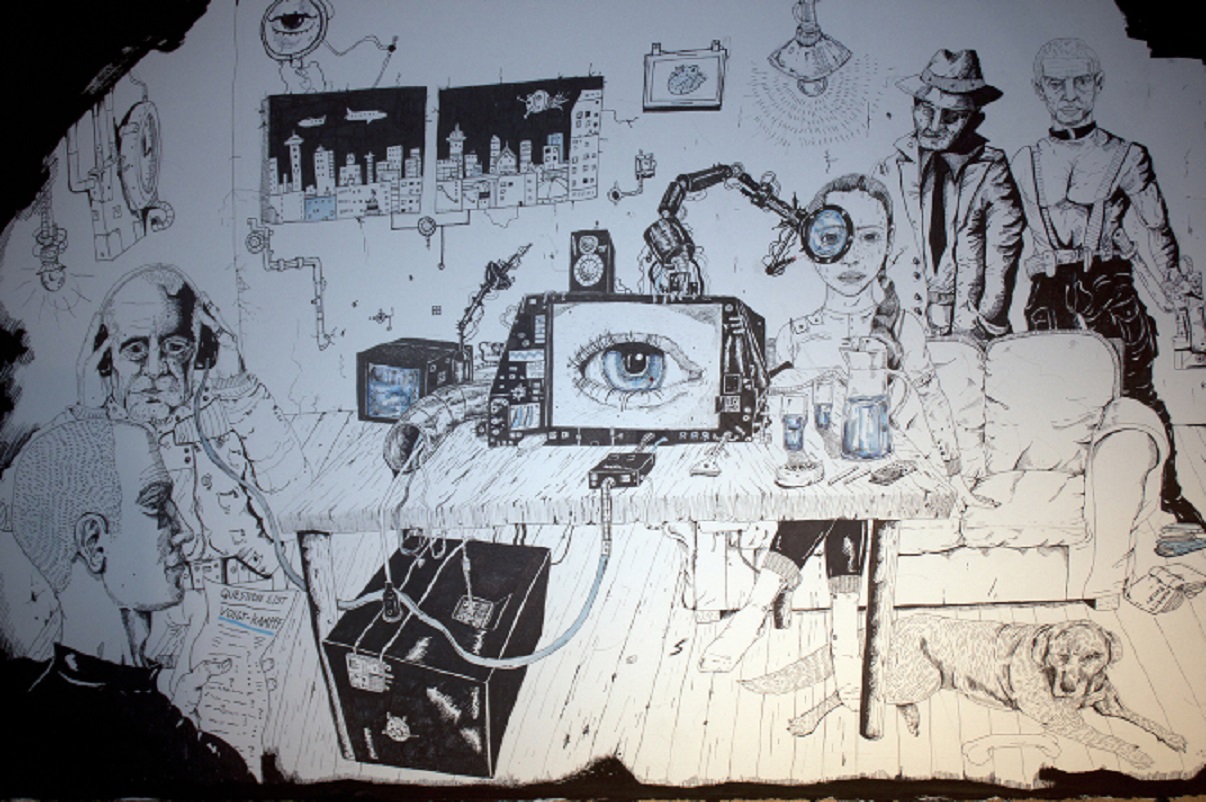Everything has been sneakily inverted on us and because this inversion is too massive a thing for us to get our heads around we are well and truly trapped by it. We are trapped by our incapacity to see that there is (or could be) such a thing as the Principle of Inversion. No matter what paranoid conspiracy theories we might be prepared to entertain (and why wouldn’t we?) we are never going to entertain this one. It’s just too big an upset to our regular way of seeing things, too big a revision of our understanding of things. This is the Big Lie Principle extrapolated to its logical extreme, we could say. In Goebbels’ original formulation of the BLP the State (by way of a clever ruse) tells a lie that is simply too enormous for us little folk to dare to question since questioning it would feel like a loss of sanity on our part. What we are talking about here goes way beyond the merely political however, this is a lie that operates on a truly cosmic scale. Lies don’t come any bigger than this…
The thing about the Big Lie is that we inevitably build our ‘little lies’ – so to speak – on it and so we are too invested in our lives to want to see the Big Lie threatened in anyway. As the character Senator Roark from the film Sin City says,
Power doesn’t come from a badge or gun. Power comes from lying. Lying big, and getting the whole damn world to play along with you.
Once we have adapted to the system then we’re on the side of the system, in other words. What we’re talking about goes way beyond what we would normally call ‘politics’ however, as we’ve just said. Traditionally, the idea of the Cosmic Inversion would be expressed in religious language; the Cathars – just to take one example – stated that there are two worlds, the Visible and the Invisible, and that the former is ruled over by the dark power of ‘Satan the Arch-Deceiver’, whilst the Invisible World of spirits is the dominion of the God of Truth and Light. Where the inversion comes in is that we get this entirely backwards, which is of course the primary Gnostic Myth of the False Creation. We take the False Creation to be the one and only true reality, whilst reality itself – which is to say, the Invisible Realm – simply doesn’t exist for us. For us, the idea of a world that can’t be seen, a world that is completely intangible, would seem utterly laughable were anyone to suggest it to us. It’s so obviously a stupid suggestion that we won’t tolerate it for a moment, and yet what makes us think that reality should be visible or comprehensible to us? Where on earth do we get that idea from?
Where we get this idea from is of course the thinking mind, and the reason the thinking mind assuming this to be the case is because this is the way thought works. Thought works by emphasizing the foreground at the expense of the background or by emphasizing what fits into its categories at the expense of what doesn’t; because this is the way thought works (and has to work) it takes it for granted (so to speak) that this is how reality works too. Reality – unlike thought – isn’t a gimmick however, and so it doesn’t need to work in this way. Reality doesn’t need to have a gimmick in order to be reality! Reality just is. Because ‘it just is’ it doesn’t need to shout, it doesn’t need to be aggressive, it doesn’t need to overshadow or overpower everything else. It doesn’t need to be a bully; it doesn’t need to broadcast itself on a megaphone, which is precisely what thought does (which is precisely what thought has to do). It’s also what the ‘mind-created sense of self’ does, as is well known! For this reason we can see that the thought-created version of the world is ‘an inversion of the natural order of things’, just as the thought-created version of ‘who we are’ is.
Rather than saying that the thought-created world (which is the world that is familiar and intelligible to us) gets to have the exclusive claim on our atttention that it does because of its ‘gimmick’, because of its ‘trick’, we could come right out with it and say that it gets to be centre stage – and more than just centre stage – by perpetrating a lie. That ‘micro-scale version’ of that lie is the single category of logic (which is nothing more than a humble ‘YES/NO flip-switch’) and a logical category works, as we have said, by highlighting whatever fits in it and ignoring or denying whatever doesn’t. The lie here is that reality itself is ‘what I say it is’ or ‘what I think it is’; we create the lie by an act of omission – we omit to say that reality only matches what we guess it to be because we make sure to screen out everything else. If we were to admit to this then that would clearly weaken our argument somewhat, to say the least! When we put all of thought’s categories together in unison, so as to create the illusion of the Defined World (which we implicitly understand to be the only world there is), then this is the Big Lie in all its glory, therefore. The Big Lie is ‘the world as we understand it to be’ – it is the only world we know, the only world we will ever know. This is the Cosmic Inversion that we are all subject to – the inversion which is responsible for reality as we know it.
When the Cathars say that the Visible World is the Domain of Satan whilst the Invisible World is the True World, the World of the God of Light, this is what they meant. This idea is also found within the conventional Christian teachings (for example, ‘Satan is the god of this world’ – 2 Corinthians 4:4) although this spooky message is not generally emphasized outside of the Jehovah’s Witnesses. To hear talk of how Satan rules over the material world naturally tends to jar our modern sensibilities somewhat; we would of course much rather entertain what we like to call ‘an objective viewpoint’ (even though such a thing doesn’t actually exist). Reason’s objective stance doesn’t actually show anything, however; such a stance shows us nothing but itself, in disguised form, as Jung says. The rational intellect lacks the imagination to appreciate the type of dark situation that can come about in the course of the evolution of a system where the basic unit is a ‘fundamental lie’. We don’t show any interest in such matters. As Jung says, ‘…we have no imagination for evil, but evil has us in its grip’.
So, one way of looking at the Inversion is to say that it is when the true Invisible World is replaced by the apparent world that is made-up of opaque 2-dimensional images (which are nothing more than our own prejudices and shortsightedness reflected back at us). A closed system (or ‘private world’) has been created and this automatically facilitates the operation of the Principle of Deception. We are flagrantly deceiving ourselves but because having our biases validated for us in this way feels so good we never look beyond it. We thus end up in a world that is every bit as small, every bit as petty, as we are and since the confirmation of our unexamined prejudices is so intensely rewarding we are more than happy to go along with this. We never look back, rushing impetuously forwards into the escape-proof lobster-pot of samsara. ‘How things actually are’ gets replaced by ‘how would like them to be’, ‘formlessness’ is replaced by ‘form’, ‘space’ is replaced by ‘opaque, 2-dimensional surfaces which we can’t see beyond’, so that we ignore and dismiss the truth every day of our lives whilst spurning the one and only true reality. We perpetually obsess over gloomy shadows rather than showing any inclination to leave the cave and experience the light and space of the outside world. This is the ironic consequence of the Inversion and it is an irony that we are profoundly oblivious to. As the alchemists pointed out, the greatest of all treasures is to be found, not where we expect, not where everyone always looks, but in the places we would automatically dismiss without a second thought. Johanne Fabricius quotes from the Tractatus aureus –
Our most precious stone, cast forth upon the dunghill, being most dear, is made the vilest of the vile.
This is the motif of ‘treasure being hidden in trash’ and this is a motif that is – in various forms – to be found in wider mythology and folktales. The very familiar story of Cinderella is one example. The Myth of the Mad King, as related here by Robert de Ropp, is another. The Gnostic version of this motif is illustrated by the following passage taken from Philip K Dick’s Exegesis –
Our minds are occluded, deliberately, so that we can’t see the prison world we’re slaves in, which is created by a powerful magician-like evil deity, who, however, is opposed by a mysterious salvific entity which often takes trash forms, and who will restore our lost memories. This entity may even be an old wino.
This is another way of talking about the Principle of Inversion therefore – we can say that ‘the Inversion’ is where we fall under some kind of dark spell which results in us ‘mistaking trash for treasure and treasure for trash’. The consequence of this mistake is that we live out the course of our lives in darkness (without knowing any better) as a kind of ‘parody that we can’t see as such’. Rumi puts it very clearly when he says that what we take to be life is really death, whilst what we understand to be death is actually life...
Image – mainstgazette.com






